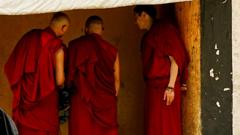In a somber reflection of life in Tibet, a monk at the Kirti monastery in Aba, Sichuan, articulates the struggles facing his community amidst a backdrop of surveillance and oppression. Just hours ago, Tibetans worldwide celebrated the 90th birthday of the Dalai Lama, whose influence continues to spark fear within the Chinese government. "Be careful, they are watching you," warns the monk, a stark reminder of the dangers involved in speaking out against the regime.
The Kirti monastery has been synonymous with Tibetan resistance since the late 2000s, when protests erupted against Beijing’s rule, leading to tragic self-immolations and violent crackdowns. Today, its significance endures, even as the Chinese Communist Party seeks to stifle Tibetan identity through infrastructure development and intensive monitoring.
Despite assertions of economic growth, many Tibetans view these advancements as a façade, concealing a systematic erosion of their civil liberties and cultural practices. Surveillance cameras and a police station now stand ominously at the monastery entrance, a constant reminder of the oppressive environment fostered by the state. "They do not have a good heart; everyone can see it," the monk observes, acknowledging the perilous conditions while alluding to the underlying spirit of resilience that persists among the oppressed.
As monks convene for early morning prayers, a palpable sense of dread and hope intertwines. "The Chinese government has poisoned the air in Tibet," one monk laments, describing a systemic oppression that denies basic human rights. After decades of exile, the Dalai Lama has proposed a future direction for Tibetan leadership, asserting that the next Dalai Lama's successor will be chosen outside of China's jurisdiction—a position the regime staunchly opposes.
With the future of Tibetan Buddhism hanging in the balance, the specter of a state-sanctioned successor looms large. In a calculated maneuver, Beijing has ramped up its propaganda, promoting a narrative that aligns the next Dalai Lama with the Communist Party's ideals, further drowning out the authentic voices of the Tibetan people.
The ideological rift deepens as Beijing employs educational systems that prioritize Mandarin and state doctrine over Tibetan language and cultural practices, leading to a future where the rich heritage risks being forgotten. Critics warn that with strict regulations on the education of Tibetan youth, the inherent connection to their roots is under siege.
Aba, once a focal point of rebellion, now bears witness to an intricate play of tradition and control. As the Dalai Lama's legacy hangs in the balance, the plight of Tibetans intensifies under the weight of systemic repression and the stubbornness of hope. As we leave the monastery, observing the balance between survival and preservation, one thing resonates: The fight to maintain authentic Tibetan identity continues amidst relentless pressure. The future remains uncertain, but the spirit of resilience stubbornly endures.




















